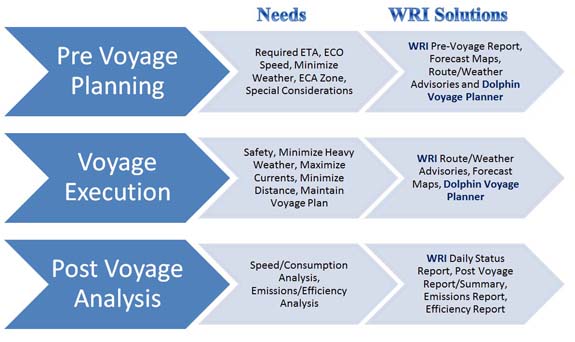
Volume 2 Issue 3, Apr 2013
|
SEEMP Compliance And How WRI Can Help
By: Michael Dore, Director of Maritime Operations
|

|
There is a tightening grip on the maritime industry which can be summed
up in two words: cost and regulations. In an effort to assist ship
operators, IMO regulations have mandated implementation of a
Ship Energy Efficiency Management Plan
(SEEMP), which
is designed for increasing
levels of vessel and fuel efficiency, while reducing greenhouse gas
emissions. Ultimately these measures, when implemented over time, will
save money through lower bunker consumption and lower vessel costs
through better vessel and voyage efficiency.
IMO Regulation MEPC.213 (63) provides "Guidance on Best Practices for Fuel-Efficient Operations for Ships", which details a number of energy improvement methods for consideration as part of a SEEMP. Weather Routing, Inc. (WRI) can assist with compliance and ship and voyage efficiency by providing tools, guidance and reports for voyage planning, voyage execution and voyage analysis.

WRI's Pre-Voyage Report is sent to the vessel/client 2 days prior to the expected departure giving a brief outline of the voyage distance and time, weather, currents and restrictions with respect to ECA zones.
WRI's detailed route/weather advisories are sent 6-8 hours prior to departure.
Each of these tools and guidance can assist in planning a cost-effective and optimum transit.
WRI's Dolphin Voyage Planner again can be utilized for up-to-date real-time and forecast data.
WRI's detailed route/weather advisories are sent from WRI's operations center. Qualified and experienced marine meteorologists and route analysts continually evaluate the vessel's route, weather, currents and hazards for the optimum transit.
WRI's Forecast Charts can be emailed to the ship giving a clear view of the weather, seas and ocean currents.
Each of these tools and guidance can assist in analyzing a cost-effective and optimum transit.
WRI's Daily Status Reports itemize the vessel's "performance" daily.
WRI's Post Voyage Analysis itemizes the vessel's distance, time, speed, weather, current and bunker consumption. Comparison is made against warranted or advised values to evaluate the ship's "performance".
WRI's Voyage Efficiency Reports are created after the transit to evaluate the route and prosecution of the voyage against a "typical or normal" voyage.
WRI's Emissions Reports itemize each vessel's greenhouse gas emissions.
Each of these tools and guidance can assist in executing a cost-effective and optimum transit.
IMO Regulation MEPC.213 (63) provides "Guidance on Best Practices for Fuel-Efficient Operations for Ships", which details a number of energy improvement methods for consideration as part of a SEEMP. Weather Routing, Inc. (WRI) can assist with compliance and ship and voyage efficiency by providing tools, guidance and reports for voyage planning, voyage execution and voyage analysis.

Pre Voyage Planning:
Voyage planning must take into account all the necessary business decisions involved in prosecuting a voyage, such as:
- Required ETA, Timed ETA or no ETA requirement.
- Minimize Bunker Costs, ECO speed versus normal speed.
- HSFO versus LSFO usage and costs in ECA zones and how to minimize.
- Bad weather: Tropical Threat, Heavy Weather, high winds/heavy seas and how to minimize/avoid and maintain schedules.
- Deck or Sensitive Cargo requiring minimum weather.
- Effects of summer, winter or tropical marks and various loaded conditions/stability concerns.
WRI's Pre-Voyage Report is sent to the vessel/client 2 days prior to the expected departure giving a brief outline of the voyage distance and time, weather, currents and restrictions with respect to ECA zones.
WRI's detailed route/weather advisories are sent 6-8 hours prior to departure.
Each of these tools and guidance can assist in planning a cost-effective and optimum transit.
Voyage Execution:
For an optimum and cost-effective transit, continuous monitoring of
distance, weather, currents and expected ETA are required. Safety is
also an ongoing concern. Whether the potential for heavy weather,
tropical threat, icebergs/sea ice, freezing spray or other hazards,
vigilance is demanded for ongoing monitor and adjustment of the planned
route.
WRI's Dolphin Voyage Planner again can be utilized for up-to-date real-time and forecast data.
WRI's detailed route/weather advisories are sent from WRI's operations center. Qualified and experienced marine meteorologists and route analysts continually evaluate the vessel's route, weather, currents and hazards for the optimum transit.
WRI's Forecast Charts can be emailed to the ship giving a clear view of the weather, seas and ocean currents.
Each of these tools and guidance can assist in analyzing a cost-effective and optimum transit.
Post Voyage Analysis:
During a voyage, and at the close of a transit, analysis is
required to evaluate the efficient prosecution of the transit for
distance, time, speed, consumption and emissions. Evaluation allows ship
operations to better estimate timing of dry-dock operations, bottom/hull
and prop cleaning, engine repairs and more in reviewing bunker rates
versus speed and emissions. Efficiency reports can show
how well the ship and weather routing company are "planning" a transit
and executing the plan. Each of these reports are critical in keeping
you and your fleet SEEMP and IMO compliant.
WRI's Daily Status Reports itemize the vessel's "performance" daily.
WRI's Post Voyage Analysis itemizes the vessel's distance, time, speed, weather, current and bunker consumption. Comparison is made against warranted or advised values to evaluate the ship's "performance".
WRI's Voyage Efficiency Reports are created after the transit to evaluate the route and prosecution of the voyage against a "typical or normal" voyage.
WRI's Emissions Reports itemize each vessel's greenhouse gas emissions.
Each of these tools and guidance can assist in executing a cost-effective and optimum transit.
Contact WRI to discuss utilizing our products and services to bring your
fleet into compliance with SEEMP and IMO Regulations. Using WRI's
services and products will mean more efficient ship operations, assists
in keeping your vessels safe, and will ultimately
lower your operating and bunker costs.
In this issue:
WRI Services:
Contact us for a Forecast!
wri@wriwx.com
+1-518-798-1110
Dolphin Online Fleet Management
Click Here
Fleet Routing
Click Here
Tropical Surveillance
Click Here
Post Voyage Performance Analysis
Click Here
Route Deviation Anaylsis & Port Consumption Reports
Click Here
Tug & Barge Services
Click Here
Cruise Liner Services
Click Here
Dolphin Voyage Planner (DVP)
Click Here
DVP Examples
Click Here
SEEMP and WRI
Click Here
 Need a Forecast?
Contact our professional meteorologists
Need a Forecast?
Contact our professional meteorologists
24 hours a day, 365 days a year at
(518) 798-1110
or wri@wriwx.com
WRI Services:
Contact us for a Forecast!
wri@wriwx.com
+1-518-798-1110
Dolphin Online Fleet Management
Click Here
Fleet Routing
Click Here
Tropical Surveillance
Click Here
Post Voyage Performance Analysis
Click Here
Route Deviation Anaylsis & Port Consumption Reports
Click Here
Tug & Barge Services
Click Here
Cruise Liner Services
Click Here
Dolphin Voyage Planner (DVP)
Click Here
DVP Examples
Click Here
SEEMP and WRI
Click Here
 Need a Forecast?
Contact our professional meteorologists
Need a Forecast?
Contact our professional meteorologists24 hours a day, 365 days a year at
(518) 798-1110
or wri@wriwx.com

